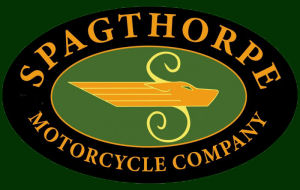

| All
this talk about the Spagthorpes reminded me of a tale my great aunt Alexis
N. Matthews* told me when I was but a young pup.
My Aunt was (I believe the story can be told now in the post-Cold War era) an arms merchant in central Asia just after The Great War (WWII). She showed me a faded black-and-white snap of the little-known Apso-Spag, manufactured by the Tibetans in Lhasa. This 600 lb monster (including side-car) was based on a design that competed with the early Cocker (code-named Collie) but canceled by Spagthorpe himself during a corporate budget exercise. I believe the snapshot was taken during the Lhasa-Katmandu Endurance race as Mt. K-2 is in the background. The model pictured was itself a prototype, according to my great-aunt. The production model was scheduled to begin manufacture the following year, but ,because of the Communist Chinese invasion, the factory was retooled to build tri-wheeled tanks. The Chinese completely destroyed the factory during the siege of Lhasa. One can still occasionally find a set of vintage Whitworth tools for sale in the Lhasa central bazaar, speculation is that they are occasionally unearthed by the nomads who have established a llama farm collective on the site of the old A-S factory. This single-cylinder on/off road monster was a unique machine. The Tibetans took the original (discarded) design and re-engineered it to run on diesel fuels, more specifically cottonseed oil, of which was plentiful at the time in Tibet. It is thought that the engine was turbo-charged, because it performed well at altitudes of over 20k ft. Also, because of the dramatic altitude changes in Tibet, the Apso-Spag came equipped with an air-compressor to automatically adjust tire pressure to changes in external air pressure (due to extreme changes in altitude or temperature). [Experiments with non-pneumatic tires proved unsatisfactory—they tended to crack in extreme cold, melt in extreme heat, and the test riders liked to mark up Lhasa’s concrete streets during stopping exercises.] Bamboo was heavily used in the manufacture of the bike, as double-leaf springs in the seat, as tubing (for fuel and for the coolant recirculation), as the shaft (this was a shafty, you know), and even as brake and clutch levers on the handle bars (one had to wear gloves while riding, according to Auntie Alexis, the levers weren't highly polished and one could get splinters under one’s nails if one wasn't careful). Too bad there are no remaining prototypes of the Apso-Spag. Perhaps, if history had been just a bit different, the A-S would have proven to be an inspiration to the Japanese bike manufactures, just as the original Spagthorpe line tended to heavily influence the American builders. We'll never know. * Curiously, my family seems to be no relation to Alex Matthews, even though my mother’s maiden name is Matthews and we were both raised in Maryland. |
| Kevin Malloy kpm@druhi.att.com AT&T Bell Labs |